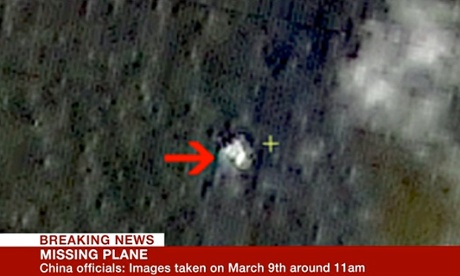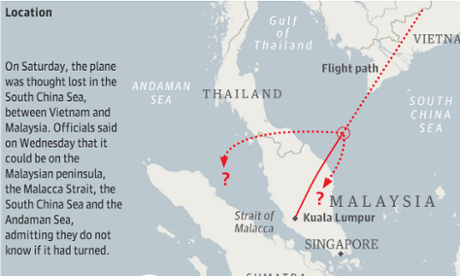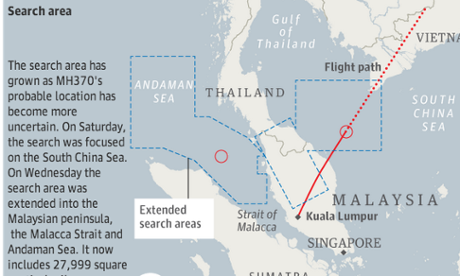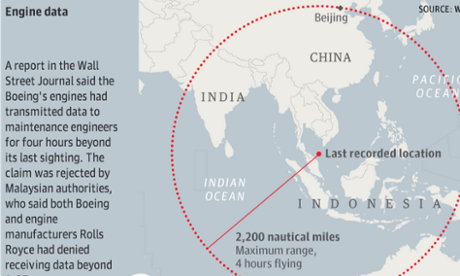
The confusion has in part been due to the number of factors at play: the 12 nations participating in the search; the menagerie of officials telling stories that don't necessarily align; the complicated way airlines run systems and safeguards; the complicated way in which airplanes function; the vast area in question; the fallibility of search technology; and, finally, the inevitable torrent of speculation by all parties, including the public.
Investigators from all countries seem to be doing their job as best they can, looking into every possible lead, whether passengers with suspect identities or a blip on a satellite image. News outlets have been less discerning in how they report their findings - or lack thereof.
Claim: Chinese satellite images show possible wreckage near flight path
After the images became public, outlets seized the "potential debris" line and aired the satellite still almost constantly. None embraced it as definitive proof that the plane had been found, though quite a bit of energy was expended on discussing the lead.

Claim: Engine signals from the plane continued after contact was lost
The Wall Street Journal reported that the plane continued flying "for about four hours past the time it reached its last confirmed location", according to unnamed American "investigators". The Journal originally reported that sources drew conclusions from data automatically sent by the plane's Rolls-Royce-made engines.
Problem: The Journal has since issued a correction, saying the signal came not from the engines but from a "satellite-communication link designed to automatically transmit the status of some onboard systems". The paper is standing by the substance of its story, though, and Reuters and CNN are also quoting unnamed sources as saying that "pings" continued after 1.07am, with Reuters explaining:
The 'pings' equated to an indication that the aircraft's maintenance troubleshooting systems were ready to communicate with satellites if needed, but no links were opened because Malaysia Airlines and others had not subscribed to the full troubleshooting service.Though neither Rolls-Royce nor Boeing have commented, Malaysia's acting transport minister, Hishammuddin Hussein, has said: "As far as Rolls-Royce and Boeing are concerned those reports are inaccurate." Hussein told the press the last transmission from the flight, at 1.07am, indicated a normally functioning flight. He went on to gravely chide the press, saying: "Whenever there are new details, they must be corroborated."
Another wrinkle: In a CNN appearance on Thursday, the former National Transportation Safety Board vice-chairman Bob Frances called the WSJ story "remarkable". In an interview with the Washington Post, he said:
"Andy Pasztor is a very reputable journalist who knows his stuff in aviation as much as anyone. For him to create this article out of whole cloth for me stretches credulity ... So you don't know where to go. I would go with what Andy said because I have great faith in him and he doesn't have any political ax to grind, as do the Malaysians."Latest: There has been no word yet from Malaysian authorities in response to the Journal's corrected report or similar leads from other outlets.
Claim: Radar signals suggest the plane entered Indian Ocean airspace
Problem: Given the technical jargon of aircraft and aircraft control, and given its overlap with the bland language of airlinese, some reports have conflated terms like "radar", "transmitter" and "transponder" and confused meanings of official reports and language from unnamed sources. Thus, it's not surprising that reports have resorted to vague words, such as "ping" and "data", which don't misrepresent the story but also aren't very clear.
Nevertheless, it appears now that investigators have expanded the search to include the Strait of Malacca and at least some region of the Indian Ocean. Hussein has so far said that the main efforts are still concentrated in the South China Sea, though parties will investigate any and all plausible leads.
As of now, the record states that the flight disappeared from civilian radar at 1.30am. Authorities have not confirmed whether a 2.15am blip, caught on Malaysian military radar near the Strait of Malacca, was MH370. Hussein, similarly, has refused to say whether the blip also dropped off military radar.
Claim: The US will search the Strait of Malacca
ABC News' Martha Raddatz first reported from a "senior Pentagon official" that the USS Kidd, an American destroyer, was moving to search for MH370 in the Indian Ocean, in what would be a major move west of the previously acknowledged search area.
Latest: White House spokesman Jay Carney confirmed that a new search area may be opened over the Indian Ocean, with Carney saying "one possible piece of information, or pieces of information" spurred the move, and that US investigators are "pursuing possible leads".
Claim: plane may have been subject to corrosion under skin of the fuselage
Last November, the US Federal Aviation Administration issued a warning about a corrosion problem that may pertain to some Boeing aircraft.
Problem: Not only has Boeing pointed out that this warning did not apply to the missing plane, but Hussein has said that the aircraft was fully serviced and passed all maintenance checks on 23 February 2014, and wasn't due for another service until 19 June.
Finally...
There have also been any number of more elaborate theories, including about passengers with suspect identities or the pilots, the latter purporting that the pilots deliberately turned off tracking devices and transmissions and proceeded to take the plane away from its flight path and/or crash it.
Authorities have not even acknowledged such speculation, though they continue to investigate all passengers and crew. Similarly, beyond the questionable identities of four passengers, no evidence exists thus far to support such conjecture.
The Malaysian communications minister has asked people not to spread rumors and police have denied the claim that they raided crew members' homes.






Reader Comments
to our Newsletter